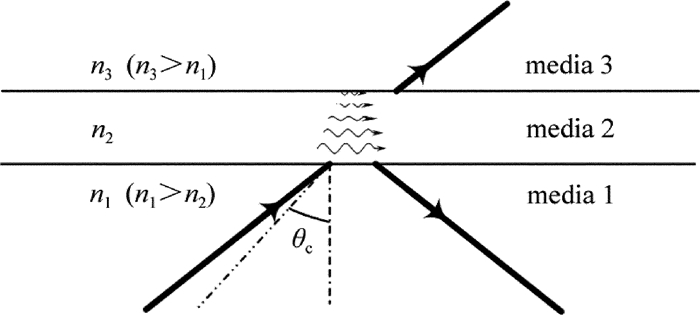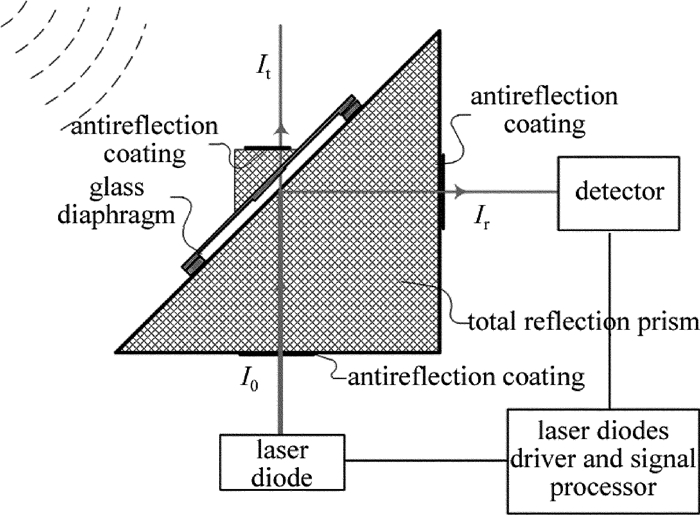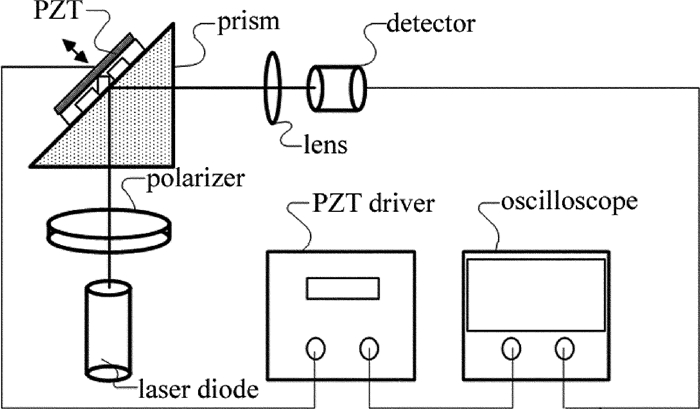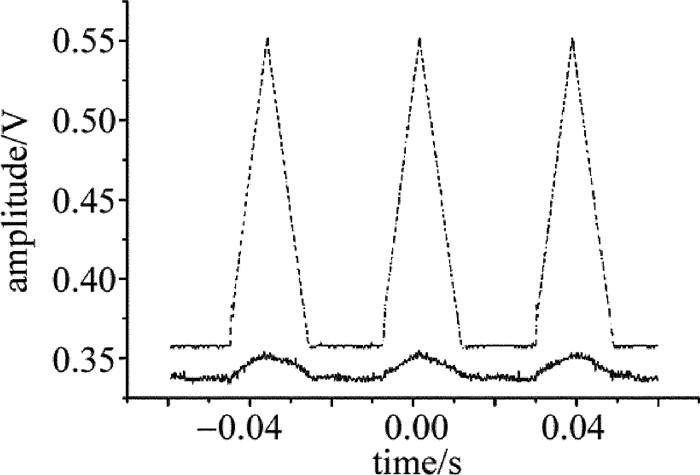A novel pickup scheme based on optical tunneling effect
-
摘要: 为了探索新型高灵敏度光电拾音器技术方案,基于光学隧穿效应研究,将声压变化转换为全反射棱镜中全反射面与摆片光学面之间的光学隧穿距离变化,从而改变光束在棱镜全反面处的反射(透射)损耗,通过直接测量反射(透射)光的功率变化,实现拾音器基本功能。利用半导体激光器和直角全反射棱镜搭建了一套简易的原理验证实验系统,并利用该系统对三角波信号驱动进行了实验。结果表明,反射光功率会随着三角波信号的改变而改变,光功率改变达到5.6%;由声音引起的玻璃振膜距离变化也可改变输出光功率,并被检测出来。初步验证了该方案的可行性。Abstract: In order to explore new high sensitivity schemes of photoelectric pickup, based on the optical tunneling effect, the change of sound pressure was translated into the change of the optical tunneling distance between the total reflection surface and pendulum optical surface of the total reflection prism. The reflection (transmission) loss of the beam at the whole opposite side of the prism was changed. The sound signal was recorded by measuring the power change of the reflected or transmitted light. To demonstrate this scheme, a set of simple experimental system was built with a semiconductor laser and a rectangular-prism, using triangular wave signal to drive the pendulous reed in the experimental apparatus. The results show that the power of the reflected light changes with the change of triangular wave signal. The variation of the power is up to 5.6%. The change of tunneling distance caused by sound signal can also affect the power of the transmitted light. The feasibility of the scheme is verified.
-
引言
拾音器是用来拾取声音信号并传送到后端的一种装置。日常生活中常见的话筒、麦克风、窃听器以及军事领域所用的声呐等都属于典型的拾音器。拾音器历史非常悠久,它对于人类获取外部信息非常重要,因为听觉是人类获取信息的第二大途径,人类90%以上的信息来自于眼睛和耳朵。早在2500年前,我国便出现应用于军事领域的高灵敏度拾音器“听瓮”,这是拾音器在我国的最早应用之一。现在拾音器已被广泛应用于各种需要进行声波传感、记录及保存等的各种重要场合,如日常生活中的录音、会议、演出、窃听以及军事应用中的侦查,如监听潜艇、舰船等[1]。
20世纪以来,随着科学技术的发展,现代拾音器技术发展迅速,由最初通过电阻拾音发展为电感、电容式拾音,同时其它大量新型拾音技术发展迅速。目前,人们常用的拾音器——麦克风通常为驻极体式麦克风,其中的电容式驻极体是在一种特殊的有机薄膜上蒸上一层很薄的金属作为一个电极(振膜),与另一极(后极)组成一个平板电容器[2]。当振膜在声波作用下产生振动时,两极之间间隙发生改变,电容量随之发生相应变化。当电容器两极之间加上恒定直流电压时,振膜的振动使平板电容的容量发生变化,极板上的电荷就会随之变化。变化的电荷流过外负载电阻,在电阻上会产生一个与声波同规律的电压降,这就实现了声能-电能的转换[3]。除传统拾音器方案外,基于光学原理的拾音器方案也被广泛研究,这些方案的本质都是基于光学原理的精密位移传感。相对于传统拾音器方案而言,光学拾音器因具有灵敏度高、抗干扰能力强、性能稳定等系列优点而备受关注,并产生了激光拾音和光纤拾音两种主要方案。由分析发现,绝大多数光学拾音器均采用干涉或者光栅传感等方式实现高灵敏度的振动测量[4],通过对声波引起振膜的振动测量,从而实现高性能拾音器功能[5]。然而,这些拾音器方案也存在结构较为复杂、稳定性较差和抗电磁干扰能力不强等缺点。针对这些弊端,本文中基于光学隧穿效应提出一种新颖光学拾音器方案,并进行了初步实验验证。
1. 光学隧穿效应基本理论
所谓光学隧穿效应,又被称为光子隧道效应或者光子隧穿效应[6]。如图 1所示,当光从折射率为n1的介质1入射向折射率为n2的介质2,且满足一定条件时(入射角不小于全反射角θc),就会发生全反射现象。
在距离介质2界面足够近处,放置另外一个折射率为n3的介质3(且n3>n2),只要间隔小到满足一定条件,介质1中的全反射现象就会受到抑制,入射光的一些光子就会穿过光疏介质的势垒,形成传输波传输出去,打破原有的全反射现象,这就是光学隧穿效应[7]。牛顿是最早观察到这种现象的学者[8],并提出了观察这种现象的方法。1965年,普林斯顿大学的研究生COON做了一个光学隧穿效应的实验,分析实验数据得出了透射率与光疏介质厚度之间的关系,与理论相符[9]。考虑特殊的情况,即介质1、介质3的折射率相等,即有n1=n3=n,且n2=1,(2π/λ)⋅√n2sin2θ−1⋅a≥1时(a为介质2的厚度,即隧穿距离),则光学隧穿效应中透射率T,即介质3中透射能流与介质1中入射能流之比[10],可表示为:
T=16n2cos2θ(n2sin2θ−1)(n2−1)2⋅ exp(−4πaλ⋅√n2sin2θ−1) (1) 式中, θ为入射角,λ为空气中激光的波长。从上式可以看出,随着光疏介质厚度的增加,隧穿光能量将以指数形式快速衰减,特别是隧穿距离接近入射光波长时,这种变化异常明显。基于(1)式,结合空气中声波的参量,可以利用MATLAB进行数值仿真。仿真条件设为a=[1+Δasin(ωt)]a0,其中Δa代表振源信号的振幅,ω代表角频率,t代表时间,a0=2.186μm代表中心位移,Δa/a0=1%,ω=1Hz,λ=0.6328μm,结果如图 2所示。可以看出,在光学隧穿距离小于波长时,在模拟声波(随时间变化的正弦信号)驱动下,隧穿距离的微小变化将导致透射率的明显变化,相对变化幅度达到10%。这表明:将声波声压转换为光学隧穿距离的变化,通过检测反射光功率的波动就可以实现将声音信号转换为光信号,进而转化为通常的电信号。
2. 基于光学隧穿效应的拾音器设计
基于上述思路,利用全反射棱镜和半导体激光器[11],设计一套基于光学隧穿效应原理的光学拾音器方案,其结构示意图如图 3所示。图 3中,系统采用可见光波段的半导体激光器作为光源,之所以选用这类激光器作为光源主要是从体积和成本考虑[12];激光器发出的激光从等腰直角棱镜(全反射棱镜)的一个镀有增透膜的直角边入射到棱镜中,以大于全反射角度入射到棱镜斜边上,形成全反射,其出射光路上放置有相应响应波长的光电探测器,用于实现光电转换[13]。在全反射棱镜全反面外侧波长量级距离处,平行放置有与棱镜相同材质的一块玻璃振膜。这样在全反棱镜斜面与玻璃振膜面之间形成光学隧穿通道,为防止玻璃振膜后表面光的干扰,玻璃振膜表面后可以利用光胶技术固定一个小尺寸直角棱镜,破坏玻璃振膜后表面的全反射条件,让隧穿光透射出去。
图 3中,I0为入射激光的光强,It为透射光的光强,Ir为反射光的光强。可以看出,上述设计方案中,当外界声音传播时,其在玻璃振膜处引起的声压变化将使得玻璃振膜振动,从而使振膜与全反射光学面之间的距离发生改变,从而改变入射激光在全反面处的透射光强。根据能量守恒的原理可知,透射光强的变化对应会产生入射光在全反射面上的反射光功率变化[14],通过反射光的变化就可以得知声音信号的变化,从而达到拾取声音的目的。上述方案中,激光在全反射棱镜两直角边的入射会导致能量的损耗[15],并会干扰探测器获取信号的信噪比[16],因此,可以在两直角面上镀制增透膜来消除这两个面可能的干扰。若不镀膜,还可以通过增大入射角,使得激光以非垂直角度入射到两直角面上,这样同时可以避免光的回馈效应对于激光器稳定性能的影响[17]。
3. 实验
按照上述设计方案,搭建初步实验系统如图 4所示。图中,光探测器用来探测输出光功率的变化[18],使之转变为相应的电压信号,输出到示波器进行显示。通常而言,探测器前面需要增加一个透镜,以便有效将激光能量聚焦到探测器光敏面上;石英材质直角三角棱镜的3个表面均为光学平面,其中斜边面上光胶有石英槽片,其结构如图 4所示:该槽片外径Ø20mm,中间开有环形的槽,槽底厚度为0.6mm,可以在外力的作用下形变,中心小柱子上开有凹球。石英槽片的小柱子后粘接有压电陶瓷(piezoelectric ceramic transducer,PZT)材料制作的驱动器,该驱动器可由信号发生器(DG1022,RIGOL)和高压放大电路组成,将所产生的三角波电压信号放大60倍,从而实现槽片微米量级的位移调节实现光学隧穿距离的精确调节,用于模拟外部声音;起偏器主要用于调节入射光的光强大小;中心波长为635nm的半导体激光器光源,工作于恒功率模式。
基于搭建的实验系统进行实验,过程如下:将半导体激光器安装在4维调节架上,开启半导体激光器之后,其发出的功率约为3mW、光斑Ø2mm,准直光束可以利用调节架调制x-y方向距离,以及俯仰、偏转角度。出射激光首先经过起偏器,调节其出射光功率大小后,以非垂直角度入射到直角棱镜的一个直角面上(主要目的是避免光回馈对于激光器性能的影响),激光以大于全反射入射角度入射到全反面(棱镜的斜面上),全反激光再次以非垂直角度入射到直角棱镜另一个直角面上,透射后,被光电探测器接收。光电探测器探测棱镜反射光的光功率,经光电转换后,输出电压信号,所探测的光功率大小与其输出电压呈正比。光电探测器为Thorlabs公司生产的可变增益探测器PDA55。探测器的输出电压连接至示波器(DS1052E,RIGOL)上。
最终实验结果如图 5所示。图中虚线是加在压电陶瓷上的电压,实线是光电探测器输出的电压变化,为便于比较,压电陶瓷信号电压按比例缩小后,其偏置电压增加0.35V以便显示。由图可看出,压电陶瓷上电压的周期变化直接导致了光学隧穿距离a的周期性变化,此时光电探测器输出信号变化规律与压电陶瓷的驱动电压相同。(1)式表明:探测器所获得的激光器透射率T与距离a呈指数关系,且光功率P与透射率T成线性关系,故光功率P也与距离a呈指数关系。实验中,由于压电陶瓷的位移与驱动电压基本呈线性关系,可知输出光功率与电压应该也为指数关系。然而,由于实验光功率只改变了大概5.6%,在此小区域范围内可近似认为线性,因此理论与实验结果符合得较好。实验装置能观察到探测器输出信号随距离a的变化,即反射光功率随距离a的变化,说明由声音引起的玻璃振膜距离变化同样可改变输出光功率且能够被检测出来,所以此拾音器方案原理是可行的。
4. 结论
基于光学隧穿效应,设计了一套光学拾音器系统,并搭建了初步的实验系统对此进行了实验研究,结果初步验证了该方案的可行性,其系统细致研究还有待后续深入。
灵敏度和频响特性是衡量一个拾音器性能的两个非常重要的方面[19]。对于本方案的灵敏度而言,初步实验中,由于采用的石英振片形变区域较厚,达到0.6mm,其对声波的灵敏度不足以使得其与光学全反射棱镜全反射面之间的距离发生明显改变。为此,后续研究中可尝试减少石英形变区域的厚度(如使之减少到数十微米量级)或者增大拾音面积等方式,相信能大大提高其灵敏度。对于频率响应问题,在初步研究中,曾采用COMSOL软件分析了直径为Ø20mm、厚度为50μm振膜的频响特征,发现当石英材质的振膜以环状方式固定在棱镜上时,在低频(小于1000Hz)段,其响应存在多个谐振峰,这意味着某些特定频率的音频信号激励时,振片在这些频率点的振幅响应将会明显增大,这显然不符合通常拾音器的频率均匀响应要求。综合分析认为,本方案中振膜的材质、结构和固定方式等都是决定其频响的重要因素。为此,后续研究可以借鉴现有麦克风振膜的设计思路,结合COMSOL软件仿真得到较为理想的结果。
-
[1] GU H C, CHENG L, HUANG J B, et al.Time division multiplexing array of fiber laser hydrophone using optical switch[J]. Laser Technology, 2016, 40(4):536-546(in Chinese). http://www.en.cnki.com.cn/Article_en/CJFDTOTAL-JGJS201604017.htm
[2] ZHENG J, LIANG H, ZHU B.Design and improvement of piezoelectric microphone[J]. Piezoelectrics & Acoustooptics, 2015, 37(3):453-455(in Chinese). http://www.wanfangdata.com.cn/details/detail.do?_type=perio&id=ydysg201503024
[3] ZHENG Ch H, LI K, SUN J.Design and implementation of a pickup for acoustic positioning[J].Science Technology and Engineering, 2016, 16(2):112-115(in Chinese). http://www.wanfangdata.com.cn/details/detail.do?_type=perio&id=kxjsygc201602022
[4] YU X L, ZHANG Z B, QU Y, et al.Research of long period bending photonic crystal fiber grating sensors[J]. Laser Technology, 2015, 39(4):571-575(in Chinese). http://www.wanfangdata.com.cn/details/detail.do?_type=perio&id=jgjs201504032
[5] TIAN K K, XIAO H, CAO Ch G, et al.Demodulation of fiber Bragg grating sensing system based on WDM fiber coupler[J]. Opto-Electronic Engineering, 2008, 32(2):49-51(in Chinese). http://www.wanfangdata.com.cn/details/detail.do?_type=perio&id=gdgc200502014
[6] LIU Q N, LIU Q.Dispersion characteristics of the total reflection tunnel effect of 1-D photonic crystal[J]. Acta Photonica Sinica, 2013, 42(5):611-615(in Chinese). DOI: 10.3788/gzxb
[7] LIU Q N, HU Ch H.Polarization and total reflection tunnel effect of flat-panel photonic crystal[J]. Laser Technology, 2012, 36(1):114-117(in Chinese). http://www.wanfangdata.com.cn/details/detail.do?_type=perio&id=QK201200191973
[8] NEWTON I. Optics[M]. Beijing:Peking University Press, 2007:125-126(in Chinese).
[9] COON D D. Counting photons in the optical barrier penetration experiment[J]. American Journal of Physics, 1966, 34(3):240-243. DOI: 10.1119/1.1972893
[10] YU D J.Optical tunneling effect[J].College Physics, 1991, 10(2):37-38(in Chinese). http://d.old.wanfangdata.com.cn/Periodical/gtxyj201504017
[11] HUANG Sh, DENG L M, YANG H, et al.Homogenization design of laser diode based on ZEMAX[J]. Laser Technology, 2014, 38(4):522-526(in Chinese). http://www.wanfangdata.com.cn/details/detail.do?_type=perio&id=jgjs201404017
[12] WANG D, LI X Q.New progress in semiconductor lasers and their applications[J]. Optics and Precision Engineering, 2001, 9(3):279-283(in Chinese). http://d.wanfangdata.com.cn/Periodical_gxjmgc200103018.aspx
[13] ZHAO Zh W, ZHANG Y J, SHEN Ch.Design of a photoelectric conversion system for pulse laser fuze[J]. Laser Technology, 2012, 36(3):326-329(in Chinese). http://www.wanfangdata.com.cn/details/detail.do?_type=perio&id=jgjs201203010
[14] MAO W, ZHANG Sh L, ZHANG L Q, et al.Optical feedback effect and the optical feedback interferometry for sensing application[J]. Optical Technique, 2007, 33(1):16-22(in Chinese). http://en.cnki.com.cn/Article_en/CJFDTOTAL-GXJS200701003.htm
[15] ZHAO H, HUA D X, DI H G, et al.Development of all time multi-wavelength lidar system and analysis of its signal to noise ratio[J]. Chinese Journal of Lasers, 2015, 42(1):0113001(in Chinese). DOI: 10.3788/CJL
[16] ZHU X P, GAN Q Q, REN G, et al.Experimental research of relative intensity noise of semiconductor lasers[J]. Laser Technology, 2005, 29(3):241-243(in Chinese). http://en.cnki.com.cn/Article_en/CJFDTOTAL-JGJS200503004.htm
[17] ZENG Zh L, DU Sh G, SUN T, et al.Polarization controlling in laser feedback and its application[J]. Laser Journal, 2015, 36(7):5-7(in Chinese). http://d.old.wanfangdata.com.cn/Periodical/jgzz201507002
[18] XIE H B, YAO L J, LI Y, et al.Design of panoramic laser receiving optical system based on prism[J]. Laser Technology, 2014, 38(5):586-589(in Chinese). http://www.wanfangdata.com.cn/details/detail.do?_type=perio&id=jgjs201405002
[19] WU F G, CAI Ch W, XU Zh.Theory of vibration[M].Beijing:Higher Education Press, 1987:21-30(in Chinese).
-
期刊类型引用(2)
1. 王玉. 交互式光感电子古筝设计模式的探索与比较. 复旦学报(自然科学版). 2021(03): 271-278 .  百度学术
百度学术
2. 白刚,菅傲群,邹璐. 基于共振光隧穿效应的加速度传感器. 激光技术. 2019(01): 43-47 .  本站查看
本站查看
其他类型引用(2)




 下载:
下载:



